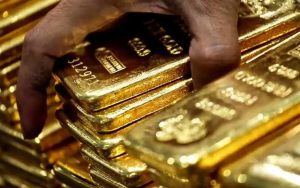Gold continues to perform strongly as a safe-haven asset, with spot prices reaching $3,250 per ounce as of April 13, 2025, a 24% year-to-date increase from January’s $2,639. Building on a 27.6% rise in 2024, gold has outperformed major indices like the S&P 500, driven by central bank demand, geopolitical tensions, and economic uncertainties. Goldman Sachs has raised its year-end 2025 gold price forecast to $3,700 per ounce and increased its tail-risk scenario to $4,500 per ounce, reflecting potential for significant price spikes under extreme conditions such as heightened policy or fiscal instability. Other banks, including UBS and J.P. Morgan, have also revised their forecasts upward. However, speculation that banks hold naked short positions in gold suggests their projections may understate the metal’s potential.
Gold’s resilience is supported by central bank purchases, persistent inflation above 2%, and trade policy developments, including proposed U.S. tariffs. The U.S. federal debt, exceeding $36 trillion, further reinforces gold’s role as a hedge against fiscal instability.
Revised Bank Forecasts
Several banks have adjusted their year-end 2025 gold price forecasts in response to gold’s strong performance:
- Goldman Sachs: On April 10, 2025, Goldman Sachs raised its forecast to $3,700 per ounce from $3,300, following earlier upgrades to $3,100 in February and $3,300 in March. The bank cites sustained central bank demand and ETF inflows, with an estimated 70 tonnes of monthly purchases compared to a prior 50-tonne forecast. Market discussions on X from March 27 to April 13, 2025, noted Goldman Sachs referencing a $4,500 per ounce tail-risk scenario under extreme conditions, such as heightened policy uncertainty or fiscal distress, though this is not their official target.
- UBS: On April 10, 2025, UBS increased its forecast to $3,500 per ounce from $3,200, highlighting tariff uncertainties, weaker economic growth, higher inflation, and geopolitical risks as key drivers.
- J.P. Morgan: J.P. Morgan maintains a $3,000 per ounce forecast for Q4 2025, emphasizing trade-related uncertainties and central bank buying (J.P. Morgan Gold Forecast).
These forecasts reflect gold’s current strength at $3,250, which is close to or exceeds some targets, indicating market expectations may be ahead of bank projections.
Bank Incentives and Transparency Concerns
Despite upward revisions, there is skepticism about the candor of bank forecasts. It is widely speculated that major financial institutions hold naked short positions in gold—selling contracts without owning the physical metal. These positions benefit from lower or stable gold prices, creating an incentive for banks to issue conservative forecasts to avoid losses or influence market sentiment. This potential conflict suggests that banks’ projections may not fully capture gold’s upside, particularly as structural demand drivers like central bank buying and ETF inflows continue to strengthen.
Driving Factors
Several factors contribute to gold’s positive outlook:
- Central Bank Demand: The 2022 freezing of Russian central bank assets following Russia’s special military operation spurred a significant increase in gold purchases, particularly by emerging market nations like China. Monthly institutional demand on the London OTC gold market rose from 17 tonnes pre-2022 to 109 tonnes in late 2024, with Goldman Sachs estimating 70 tonnes monthly in 2025 (Gold prices are forecast to rise another 8% this year).
- Geopolitical and Trade Tensions: Proposed U.S. tariffs, including 25% on steel and aluminum, and broader policy uncertainties, such as discussions around a “Mar-a-Lago Accord” for global trade restructuring, enhance gold’s safe-haven appeal.
- Monetary Policy and Interest Rates: Expectations of two 25-basis-point Federal Reserve rate cuts in 2025 and one in early 2026 favor gold. Lower interest rates reduce the appeal of dollar-denominated assets like bonds, as their yields decline, driving investors toward gold and supporting ETF inflows.
- Chinese Insurance Demand: China’s policy allowing insurers to allocate up to 1% of assets under management to gold—potentially 280 tonnes—could stabilize prices during dips, with latent demand expected to emerge.
Potential Risks
While gold’s outlook is positive, certain factors could temper gains:
- U.S. Dollar Strength: A stronger dollar could raise gold’s cost for non-dollar investors, potentially limiting price increases.
- Geopolitical Developments: Resolutions to conflicts, such as Russia-Ukraine, could reduce central bank demand, though ongoing tensions suggest this is unlikely.
Market Implications
The revised forecasts—Goldman Sachs at $3,700, UBS at $3,500, and J.P. Morgan at $3,000—signal confidence in gold’s trajectory, though the current $3,250 price suggests markets may anticipate further gains. The $4,500 tail-risk scenario, noted in X discussions and a Kaohoon International article as a Goldman Sachs reference for extreme conditions, underscores potential upside but is not a primary forecast. Speculation about banks’ naked short positions implies forecasts may be restrained. Central bank demand, amplified by the 2022 Russian asset freeze, and emerging Chinese insurance demand are key supports.
Conclusion
Gold’s strong performance has prompted banks like Goldman Sachs, UBS, and J.P. Morgan to raise their year-end 2025 forecasts to $3,700, $3,500, and $3,000 per ounce, respectively. Goldman Sachs has also referenced a $4,500 tail-risk scenario in market discussions for extreme conditions. However, beliefs that banks hold naked short positions in gold suggest their forecasts may understate potential gains. Central bank buying, geopolitical tensions, and lower interest rates, which reduce demand for dollar-denominated assets, underpin a positive outlook. Despite risks like a stronger dollar, gold’s trajectory remains upward through 2025.








Be First to Comment